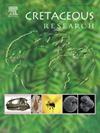The first record of a predaceous clerid beetle (Coleoptera: Cleridae) from the Cretaceous Taimyr amber
IF 1.7
3区 地球科学
Q1 GEOLOGY
引用次数: 0
Abstract
Cleroid beetle Aiytillus agapensis gen. et sp. nov. is described from upper Cenomanian Taimyr amber. This is the first finding of a predatory checkered beetle (Cleridae) in the Cretaceous. Based on the tarsi with equally large tarsomeres 1–4, the fossil is unambiguously assigned to the basal clerid subfamily Tillinae. The fossil was found near the Nizhnyaya Agapa River in the upper horizon of the Dolgan Formation during an expedition in 1973. Although damaged by improper preservation, the fossil exhibits a number of interesting morphological details including extremely small body (less than 3 mm), long serrated antenna, pretarsal claw with denticle, and comb-like protibial structures. The unusually long antenna together with the aforementioned morphological characters resembles another small tilline fossil Bilbotillus glum Kolibáč from Baltic Amber, although the latter is about 60 My younger. The presence of modern looking clerids in the Middle Jurassic of NE China as well as in Taimyr and Baltic ambers, and conversely their absence in burmite, may indicate the origin of the family in temperate rather than tropical conditions.
白垩纪泰米尔琥珀中首次发现一种掠食性甲虫(鞘翅目:甲虫科)
在上诺曼尼亚泰米尔琥珀中发现了甲虫Aiytillus agapensis gen. et sp. 11。这是白垩纪首次发现的掠食性方格甲虫。根据具有同样大的1-4型跗骨的跗骨化石,该化石被明确地归属于基冠亚科。该化石是在1973年的一次探险中,在Dolgan组上部的Nizhnyaya Agapa河附近发现的。虽然由于保存不当而受损,但化石显示出许多有趣的形态学细节,包括极小的身体(小于3毫米),长锯齿状天线,带小齿的前爪和梳状的胫骨结构。异常长的触角加上上述形态特征,与波罗的海琥珀中的另一种小型tilline化石Bilbotillus glum Kolibáč相似,尽管后者大约年轻60岁。在中国东北中侏罗世以及泰米尔和波罗的海琥珀中发现了具有现代外观的硬石,而相反,它们在burmite中却没有出现,这可能表明该科的起源是在温带而不是热带条件下。
本文章由计算机程序翻译,如有差异,请以英文原文为准。
求助全文
约1分钟内获得全文
求助全文
来源期刊

Cretaceous Research
地学-地质学
CiteScore
4.10
自引率
19.00%
发文量
235
审稿时长
12 weeks
期刊介绍:
Cretaceous Research provides a forum for the rapid publication of research on all aspects of the Cretaceous Period, including its boundaries with the Jurassic and Palaeogene. Authoritative papers reporting detailed investigations of Cretaceous stratigraphy and palaeontology, studies of regional geology, and reviews of recently published books are complemented by short communications of significant new findings.
Papers submitted to Cretaceous Research should place the research in a broad context, with emphasis placed towards our better understanding of the Cretaceous, that are therefore of interest to the diverse, international readership of the journal. Full length papers that focus solely on a local theme or area will not be accepted for publication; authors of short communications are encouraged to discuss how their findings are of relevance to the Cretaceous on a broad scale.
Research Areas include:
• Regional geology
• Stratigraphy and palaeontology
• Palaeobiology
• Palaeobiogeography
• Palaeoceanography
• Palaeoclimatology
• Evolutionary Palaeoecology
• Geochronology
• Global events.
 求助内容:
求助内容: 应助结果提醒方式:
应助结果提醒方式:


